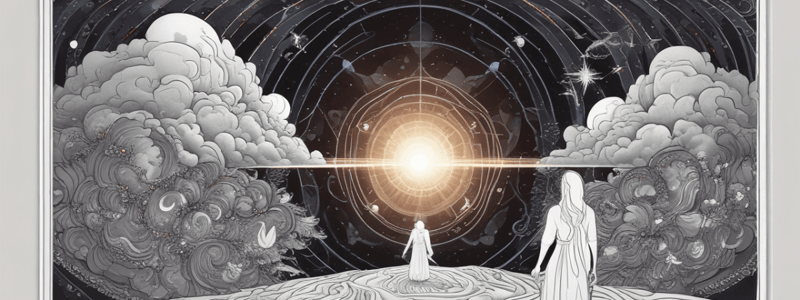Podcast
Questions and Answers
Normal waking consciousness is characterized by marked differences in awareness compared to altered states of consciousness.
Normal waking consciousness is characterized by marked differences in awareness compared to altered states of consciousness.
True (A)
Altered states of consciousness can only be induced through psychological drugs.
Altered states of consciousness can only be induced through psychological drugs.
False (B)
Experiences during normal waking consciousness do not influence how we perceive altered states.
Experiences during normal waking consciousness do not influence how we perceive altered states.
False (B)
Meditation is considered a technique that can lead to an altered state of consciousness.
Meditation is considered a technique that can lead to an altered state of consciousness.
Drowsiness during a lesson is an example of a state that is opposite to normal waking consciousness.
Drowsiness during a lesson is an example of a state that is opposite to normal waking consciousness.
Psychosis is classified as a minor deviation from normal waking consciousness.
Psychosis is classified as a minor deviation from normal waking consciousness.
Your awareness of thoughts and feelings remains constant throughout the entire day.
Your awareness of thoughts and feelings remains constant throughout the entire day.
Altered states of consciousness are often irrelevant to cultural experiences.
Altered states of consciousness are often irrelevant to cultural experiences.
Match the following classes of psychoactive drugs with their descriptions:
Match the following classes of psychoactive drugs with their descriptions:
Match the following drugs with their primary effects:
Match the following drugs with their primary effects:
Match the following drug classes with their mechanism of action:
Match the following drug classes with their mechanism of action:
Match the following effects with the corresponding class of psychoactive drugs:
Match the following effects with the corresponding class of psychoactive drugs:
Match the following psychoactive drug classes with their examples:
Match the following psychoactive drug classes with their examples:
Flashcards are hidden until you start studying
Study Notes
Normal Waking Consciousness
- Characterized by awareness of thoughts, feelings, and surroundings.
- Involves understanding of time, self-identity, and social context.
- Considered an organized and clear state of awareness.
- Serves as a baseline for evaluating other consciousness states.
- Level of awareness can fluctuate throughout daily activities and lessons.
- Focusing on tasks may lead to moments of distraction or drowsiness.
Altered States of Consciousness
- Defined as deviations from normal waking consciousness.
- Marked by changes in awareness, perceptions, memory, emotions, and sense of time and self-control.
- Induced by various factors, including:
- Meditation techniques.
- Psychological substances, like alcohol.
- Physiological conditions such as fever.
- Mental health conditions, particularly psychosis.
- Spontaneous states like daydreaming or sleep.
- Can be culturally significant, often tied to religious experiences.
- May occur both deliberately and naturally.
Stimulants
- Stimulants are a category of psychoactive drugs that enhance alertness and energy.
- They act by blocking the reuptake of key neurotransmitters: dopamine, norepinephrine, and serotonin.
- This action occurs in the synapses, facilitating increased communication between neurons in the central nervous system.
Depressants
- Depressants are psychoactive drugs that lower the activity level of the central nervous system (CNS).
- These substances can promote relaxation, decrease anxiety, and induce sedation.
- Common examples include alcohol, benzodiazepines, and barbiturates.
Opioids
- Opioids are chemicals that engage opioid receptor neurons, located in the brain and digestive system.
- Their effects include producing euphoria, analgesia (pain relief), and slower breathing rates.
- Opioids can also lead to constipation, a common side effect due to their action on the digestive system.
Hallucinogens
- Hallucinogens are a class of psychoactive drugs that significantly alter sensation and perception.
- They can cause visual and auditory hallucinations, changing a person's experience of reality.
- Common examples include LSD, psilocybin (magic mushrooms), and mescaline.
Studying That Suits You
Use AI to generate personalized quizzes and flashcards to suit your learning preferences.




